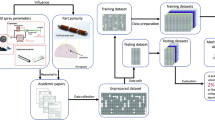Abstract
Purpose. Reliable methods are needed to characterize the surface roughness of pharmaceutical solid particles for quality control and for finding the correlation with other properties. In this study, we used fractal analysis to describe the surface roughness.
Methods. Atomic force microscopy (AFM) was used to obtain three-dimensional surface profiles. The variation method was used to calculate fractal dimensions. We have measured fractal dimensions of four granule samples, four powders, and two freeze-dried powders.
Results. A computer program was written to implement the variation method. The implementation was verified using the model surfaces generated by fractional Brownian motion. The fractal dimensions of most particles and granules were between 2.1 and 2.2, and were independent of the scan size we measured. The freeze-dried samples, however, showed wide variation in the values of fractal dimension, which were dependent on the scan size. As scan size increased, the fractal dimension also increased up to 2.5.
Conclusions. Fractal analysis can be used to describe surface roughness of pharmaceutical particles. The variation method allows calculation of reliable fractal dimensions of surface profiles obtained by AFM. Careful analysis is required for the estimation of fractal dimension, since the estimates are dependent on the algorithm and the digitized model size (i.e., number of data points of the measured surface profile) used. The fractal dimension of pharmaceutical materials is also a function of the observation scale (i.e., the scan size) used in the profile measurement. The multi-fractal features and the scale-dependency of fractal dimension result from the artificial processes controlling the surface morphology.
Similar content being viewed by others
REFERENCES
S. R. Byrn. Solid State Chemistry of Drugs, Academic Press, New York, 1982
H. G. Brittain, S. J. Bogdanowich, D. E. Bugay, J. DeVincentis, G. Lewen, and A. W. Newman. Physical characterization of pharmaceutical solids. Pharm. Res. 8:963-973 (1991).
M. A. Ramadan and R. Tawashi. Effect of surface geometry and morphic features on the flow characteristics of microsphere suspensions. J. Pharm. Sci. 79:929-933 (1990).
P. D. Nadkarni, D. O. Kildsig, P. A. Kramer, and G. S. Banker. Effect of surface roughness and coating solvent on film adhesion to tablets. J. Pharm. Sci. 64:1554-1557 (1975).
T. Oshima, Y.-L. Zhang, M. Hirota, M. Suzuki, and T. Nakagawa. The effect of the types of mill on the flowability of ground powders. Adv. Powder Technol. 6:35-45 (1995).
C.-T. Lee and C. C.-K. Chou. Application of fractal geometry in quantitative characterization of aerosol morphology. Part. Part. Syst. Charact. 11:436-441 (1994).
R. Thibert, M. Akbarieh, and R. Tawashi. Application of fractal dimension to the study of the surface ruggedness of granular solids and excipients. J. Pharm. Sci. 77:724-726 (1988).
J. M. Bennett. Recent developments in surface roughness characterization. Meas. Sci. Technol. 3:1119-1127 (1992).
R. M. Hall, A. Unsworth, P. Siney, and B. M. Wroblewski. The surface topography of retrieved femoral heads. J. Mater. Sci. Mater. Med. 7:739-744 (1996).
T. Provder and B. Kunz. Application of profilometry and fractal analysis to the characterization of coatings surface roughness. Prog. Org. Coat. 27:219-226 (1996).
S. R. Brown and C. H. Scholz. Broad bandwidth study of the topography of natural rock surfaces. J. Geophys. Res. 90:12575-12582 (1985).
W. L. Power and T. E. Tullis. Euclidean and fractal models for the description of rock surface roughness. J. Geophys. Res. 96:415-424 (1991).
B. B. Mandelbrot. Fractals: Form, Chance, and Dimension, W. H. Freeman, San Francisco, 1977
D. Farin and D. Avnir. Reactive fractal surfaces. J. Phys. Chem. 91:5517-5521 (1987).
B. H. Kaye. Characterizing the structure of fumed pigments using the concepts of fractal geometry. Part. Part. Syst. Charact. 8:63-71 (1991).
F. Family, P. Meakin, B. Sapoval, and R. Wool (eds.), Fractal Aspects of Materials, Materials Research Society, Pittsburgh, 1995.
A. Seri-Levy and D. Avnir. Fractal analysis of surface geometry effects on catalytic reactions. Surf. Sci. 248:258-270 (1991).
D. Avnir, D. Farin, and P. Pfeifer. Surface geometric irregularity of particulate materials: The fractal approach. J. Colloid Interface Sci. 103:112-123 (1985).
Y. H. Lee, J. R. Carr, D. J. Barr, and C. J. Haas. The fractal dimension as a measure of the roughness of rock discontinuity profiles. Int. J. Rock Mech. Min. Sci. Geomech. Abstr. 27:453-464 (1990).
B. Dubuc, S. W. Zucker, C. Tricot, J. F. Quiniou, and D. Wehbi. Evaluating the fractal dimension of surfaces. Proc. R. Soc. Lond. A. 425:113-127 (1989).
B. Dubuc, J. F. Quiniou, C. Roques-Carmes, C. Tricot, and S. W. Zucker. Evaluating the fractal dimension of profiles. Phys. Rev. A. 39:1500-1512 (1989).
B. Dubuc and S. Dubuc. Error bounds on the estimation of fractal dimension. SIAM J. Number. Anal. 33:602-626 (1996).
S. Ganti and B. Bhushan. Generalized fractal analysis and its applications to engineering surfaces. Wear 180:17-34 (1995).
A. Majumdar and B. Bhushan. Role of fractal geometry in roughness characterization and contact mechanics of surfaces. J. Tribol. 112:205-216 (1990).
R. Thibert, B. Dubuc, M. Dufour, and R. Tawashi. Evaluation of the surface roughness of cystine stones using a visible laser diode scattering approach. Scanning Microsc. 7:555-561 (1993).
M. F. Barnsley, R. L. Devaney, B. B. Mandelbrot, H.-O. Peitgen, D. Saupe, R. F. Voss, Y. Fisher, and M. McGuire. The Science of Fractal Images, Springer-Verlag, New York, 1988.
Q. Huang, J. R. Lorch, and R. C. Dubes. Can the fractal dimension of images be measured? Pattern Recognit. 27:339-349 (1994).
J. Nittmann and H. E. Stanley. Non-deterministic approach to anisotropic growth patterns with continuously tunable morphology: The fractal properties of some real snowflakes. J. Phys. A. 20:L1185-L1191 (1987).
J. Kertész and T. Vicsek. Diffusion-limited aggregation and regular patterns: Fluctuations versus anisotropy. J. Phys. A. 19:L257-L260 (1986).
J. C. Sommerer and E. Ott. Particles floating on a moving fluid: A dynamically comprehensible physical fractal. Science 259:335-339 (1993).
Author information
Authors and Affiliations
Rights and permissions
About this article
Cite this article
Li, T., Park, K. Fractal Analysis of Pharmaceutical Particles by Atomic Force Microscopy. Pharm Res 15, 1222–1232 (1998). https://doi.org/10.1023/A:1011939824353
Issue Date:
DOI: https://doi.org/10.1023/A:1011939824353




